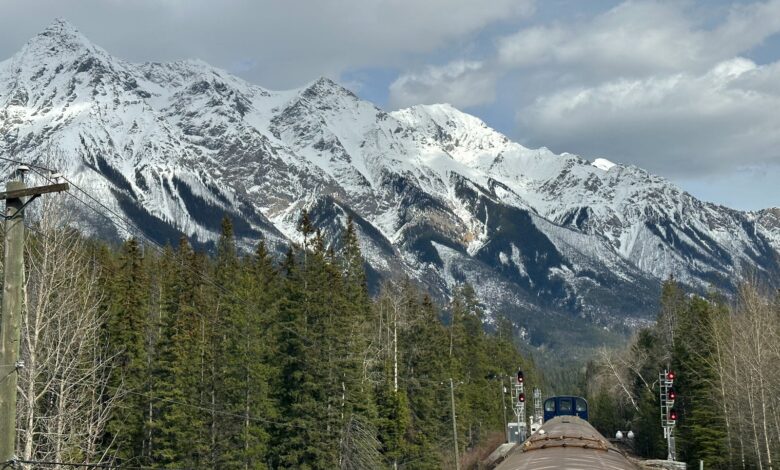How to choose between Rocky Mountaineer’s most popular routes

Editor’s note: TPG was invited on this route as guests of Rocky Mountaineer. All opinions are the author’s own and were not subject to review by Rocky Mountaineer.
For many travelers, no first-class airline suite or classic road trip can compete with the leisurely, decadent experience of crossing some of the world’s most scenic landscapes on a luxury train.
And when it comes to the varied, dramatic scenery of western North America (the towering, snowcapped peaks of the Rocky Mountains, the Martian-like red rocks of the American West), only one brand dominates the space.
And no, it’s not Amtrak.
Rocky Mountaineer, a Canadian company that’s been taking travelers on high-end rail tours of western Canada for more than 30 years, launched its first U.S. route in 2021. Called Rockies to the Red Rocks, this itinerary connects Moab, Utah, with Denver, Colorado, and offers travelers a new way to experience the iconic train, which has historically remained in Canada.
I got to experience that journey with my colleague, Summer Hull, last fall. And six months later, I was invited to reunite with Rocky Mountaineer on its classic First Passage to the West route. Tracing a line between Vancouver, British Columbia, and Banff, Alberta, this legendary tour includes a stop in Kamloops, British Columbia, crosses the Continental Divide and corkscrews through the Spiral Tunnels before concluding at Lake Louise and Banff National Park.
But it’s not just the destinations that are different. If you’re contemplating your first-ever trip with Rocky Mountaineer, here are some other differences to consider.
Related: 11 of the most scenic train rides on Earth
At your service
During my trip with Rocky Mountaineer in the U.S., I got to experience SilverLeaf Plus, the highest level of service offered on this route. For about $500 more than the entry-level fares, travelers in SilverLeaf Plus get access to more local wines and spirits and can spread out beyond the standard observation car and into the lounge cars — perfect for whiling away the hours while admiring the scenery, elbowing up to a bar (on a train!) to order cocktails, playing classic board games and exchanging stories with other travelers.
Sign up for our daily newsletter
1 of 5
SUMMER HULL/THE POINTS GUY
On the other hand, travelers who opt for one of the classic Canadian journeys can experience the operator’s iconic GoldLeaf service. Guests in this class get to spend the journey in a double-decker car: Breakfast and lunch services are organized on the lower level, just like a fine dining restaurant (albeit a bit more turbulent), complete with white tablecloths, while the upstairs is reserved for admiring the scenery in a stunning bi-level glass-domed observation car. These cars can’t fit through the lower tunnels in the U.S., so Rocky Mountaineer hasn’t been able to replicate this service on its Rockies to the Red Rocks route. At least, not yet.
1 of 4
COLBY KIRKPATRICK/THE POINTS GUY
It’s hard to underscore what a difference it makes to not have to take your meals at the same seat you’re sitting in, napping in and chatting in for two days or more. Migrating downstairs for meal services harks back to the golden age of travel when flight attendants carved chateaubriands for flyers and entire dessert buffets were presented to guests on the Orient Express.
The GoldLeaf train cars are also much more modern, with wider, heated leather seats that swivel to create more intimate sitting areas for groups, and advanced controls to adjust everything from pitch to lumbar support.
But for travelers looking to save money, the SilverLeaf service — nearly identical to the entry-level SilverLeaf service offered on the American route — is still a far more upscale way to journey along the rails than standard passenger trains.
And even though SilverLeaf Plus is undoubtedly Rocky Mountaineer’s version of premium economy, and GoldLeaf is a clear cut above (think: business class on your favorite international airline), I’ll admit I missed the lounge cars while ambling along the tracks in western Canada. The lounge cars, with their player pianos and full bar service, snacks and convivial atmosphere, felt far more consistent with the romantic Agatha Christie-esque visions of rail travel I’d daydreamed about (minus the murder, of course).
Related: How to plan your 1st luxury train trip
Fine dining (and drinking)
One of the highlights of traveling with Rocky Mountaineer is the excellent food and beverage program featuring multi-course lunch and breakfast services and unlimited beverages.
During the Rockies to the Red Rocks trip, which offered three breakfast choices and two lunch options, I tucked into a breakfast frittata with roasted yams, peppers and onions, plus a side of veggie sausage (available upon request) and flavorful vegetarian flautas for an afternoon snack. Meals are served at your seat, on tray tables (airplane style, I like to call it) but are dressed up with white linens and elegant flatware.
1 of 5
SUMMER HULL/THE POINTS GUY
The highlight, though, was probably sipping a fresh-made bloody mary while munching on bar snacks in the lounge car, plus the assortment of pastries and desserts sourced from local bakeries along the route.
While traveling from Vancouver to Lake Louise, the dining experience was of an entirely different caliber. In addition to the luxury of not eating at your seat, each meal offered more dishes to choose from, and the food was, overall, more elaborate (Rocky Mountaineer chefs must contend with smaller galleys on the U.S. route). Throughout the two-day trip, I enjoyed plates of Louis Lake steelhead with handmade gnocchi, Moroccan-spiced cauliflower and chickpeas, and avocado toast topped with smoked salmon and a soft-boiled egg.
1 of 4
COLBY KIRKPATRICK/THE POINTS GUY
Though there were no lounge cars with bars, you could order endless beverages, including Canada’s answer to the bloody mary: a caesar.
One gripe is that espresso beverages aren’t served on board the Rocky Mountaineer. I know space is at a premium, but there is a galley where chefs turn out almost everything (except, specifically, birthday cakes), and I would have loved to sip a foamy cappuccino while watching the Rocky Mountains as we zipped by.
Related: 4 great scenic train rides across the US
Diverse — but equally dramatic — landscapes
There’s no comparing the American Southwest and its vermillion-hued rock formations to the snowcapped spires of the Canadian Rockies.
And though both trains cross the Continental Divide and traverse the Rocky Mountains during the journey, no itinerary is better or more scenic than the next. Travelers should decide if they want to bookend a journey on board the Rocky Mountaineer with mountain biking, rock climbing and stark desert hikes in the surreal landscapes of Canyonlands and Arches National Park or if they prefer the cooler mountain temperatures of Canada’s western national parks, where similar diversions might include hiking and canoeing or, in the winter, skiing and snowshoeing.
During our journey from Colorado to Utah, we passed through aspens tipped with late autumn gold, mountains covered in evergreens and the blushing sandstone cliffs of Ruby Canyon.
The train hugged the Colorado River as we continued west, steam fog rising from the water in the early morning, and we saw everything from eagles and elk to chipmunks and even bare-bottomed paddlers partaking in the time-honored tradition of mooning the passing train. Our journey concluded at the junction of some of the most iconic parklands in the U.S., including Dead Horse Point State Park, Canyonlands National Park and Arches National Park, all marked by impossibly vibrant rock formations and scenic vistas, including gravity-defying hoodoos and natural bridges.
1 of 8
SUMMER HULL/THE POINTS GUY
While traveling east from Vancouver to Lake Louise, the scenery was marked by the frothy whitewater rapids of Kicking Horse River, dramatic mountain passes and, perhaps most notably, the astonishing engineering feat of the Spiral Tunnels, which made the spires of the Rockies accessible with trains and provided some of the most stunning views from the entire trip.
1 of 11
COLBY KIRKPATRICK/THE POINTS GUY
As with the U.S. journey, the wildlife we saw in Canada was surprisingly abundant, including bald eagles, elk and osprey.
It’s a good thing these trains aren’t equipped with Wi-Fi, because it encourages you to put down your devices and keep your eyes glued to the oversized windows.
Whistle-stops
Since Rocky Mountaineer trains aren’t equipped with sleeper cars, travelers must disembark in the evening and spend the night in a hotel (these overnights are included in the cost of your stay).
I found Glenwood Springs, Colorado — the scheduled whistle-stop for the Rockies to the Red Rocks route — to be a much more appealing place to visit, in part because you can simply walk off the train and into town. During the stop, travelers can dip in the town’s namesake hot springs (which claim to be the largest mineral hot springs pool on earth) and explore the walkable, distinctly Western town center.
1 of 3
SUMMER HULL/THE POINTS GUY
The First Passage to the West itinerary includes a stop in Kamloops — a city (population: approximately 100,000) known for hosting sporting events that didn’t feel as approachable for a quick overnight. After disembarking, travelers must board a bus to the town center. Admittedly, we arrived later in the evening on this trip and only had time for a quick bite at The Noble Pig, a microbrewery specializing in hand-crafted beers and fried pickles.
But Kamloops does have a distinct edge with its accommodations, which feel appropriate for the Rocky Mountaineer experience. We spent the night at the Delta Hotel Kamloops, a rebranded and renovated property that welcomed guests in 2019. The contemporary downtown hotel is hardly a Fairmont (the iconic grande dame hotels that bookended our stay in Vancouver and Lake Louise). Still, it felt fresh and featured thoughtful amenities like argan oil Soapbox toiletries and a heated rooftop pool.
1 of 3
COLBY KIRKPATRICK/THE POINTS GUY
Unfortunately, the hotel I stayed at in Glenwood Springs did not meet the high standard set on board the train. Rocky Mountaineer partners with three hotels in Glenwood Springs: Hotel Colorado, The Hotel Denver and Glenwood Hot Springs Lodge. We stayed at the lodge, which was dark and dated.
Regardless of where you stay during an overnight with Rocky Mountaineer, one knockout service remains the same: Your luggage, aside from any hand baggage you keep with you on the train, is driven ahead and placed in your hotel room before your arrival. You’ll even be checked in and given keys to your room before leaving the train.
Related: 9 mistakes travelers make on their 1st train trips
The cost
Of course, sometimes choosing one trip or another comes down to cold hard cash. Rocky Mountaineer’s shortest First Passage to the West journeys, like the one I experienced last month, start around $1,500 per person this year, based on double occupancy. Upgrading to GoldLeaf service would mean starting rates closer to $2,100 per person. Entry-level two-day journeys on the Rockies to the Red Rocks route are similarly priced at $1,400 per person — or closer to $1,980 for SilverLeaf Plus.
In both instances, you can expect to spend about $500 more per person for Rocky Mountaineer’s most premium services. With that in mind, the GoldLeaf service feels like a far better use of that extra cash compared to the SilverLeaf Plus product. But entry-level fares on both routes are comparable, meaning travelers should think closely about the scenery and the destinations along the route, including your departure city, arrival city and the whistle-stop.
However, travelers may also gravitate toward the more social, old-timey atmosphere in the SilverLeaf Plus lounge cars.
Traveling with Rocky Mountaineer isn’t cheap, particularly when you consider you’re on your own for dinner during the whistle-stop. Travelers might liken a journey with Rocky Mountaineer to an all-inclusive stay at a luxury hotel, or even a safari experience. But typically, three daily meals will be included, and the level of luxury will be consistent. The hotels you’ll find in Kamloops and Glenwood Springs are far from the luxury you might expect from a $1,500-per-night resort. Many of our favorite all-inclusive resorts on the planet, in fact, are more affordable, and those prices are based on double occupancy.
Since Rocky Mountaineer’s prices are per person, a couple can expect to spend upward of $3,000 per person for the two-day journey.
Rocky Mountaineer’s pricing becomes much more palatable if you take advantage of the numerous discounts and promotions offered throughout the year. With one of its current promotions (which expires Wednesday!), you can save $780 per couple on Canadian routes and $1,000 per couple on the Rockies to the Red Rocks itinerary.
If these prices are still too eye-watering, travelers can experience the romance of the rails on board a more affordable, no-frills passenger train like Amtrak in the U.S. (the California Zephyr route will trace the same line from Denver to Glenwood Springs, though it concludes in San Francisco instead of the red-rock country of Utah). You’ll be on your own for food, of course.
In Canada, Via Rail offers a 20-hour trip between Vancouver and Jasper, Alberta (where onward connections to Banff are available by bus). Travelers can choose from a standard economy fare, an individual sleeping berth or splurge on a private sleeper cabin with three square meals included — the latter of which can easily cost more than a journey with Rocky Mountaineer. Another consideration is that you’ll miss an entire day’s scenery since Via Rail travels overnight. It’s a more expeditious trip, and for travelers in economy, it can certainly be a more affordable option.
Unlike Via Rail and Amtrak, Rocky Mountaineer journeys are far more focused on maximizing the scenery. Since the train only operates during the day, you won’t miss a moment. And with its skilled, amiable onboard hosts to provide context and anecdotes, and the train cars designed for enjoying sweeping vistas, it’s more like a tour than a mode of transportation.
Bottom line
Though we’ve only highlighted two of Rocky Mountaineer’s routes here, travelers could also book itineraries that originate in, or depart from, Jasper, or extend their trips with packages that include bus transport to nearby destinations and attractions.
Whatever you do, remember to put down your phone – or even your book — and take a look outside the window, whether you’re in a glass-domed GoldLeaf car, lounging around with other travelers or standing outside on a viewing platform. After all, taking time to slow down and enjoy the scenery is what rail travel is all about.
Related reading:




